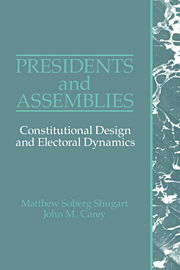Book contents
- Frontmatter
- Contents
- List of tables and figures
- Acknowledgments
- 1 Basic choices in democratic regime types
- 2 Defining regimes with elected presidents
- 3 Criticisms of presidentialism and responses
- 4 The premier-presidential and president-parliamentary experiences
- 5 The constitutional origins of chief executives
- 6 Constitutional limits on separate origin and survival
- 7 Legislative powers of presidents
- 8 Assessing the powers of the presidency
- 9 Electoral dynamics: efficiency and inefficiency
- 10 Electoral rules and the party system
- 11 Electoral cycles and the party system
- 12 Electoral cycles and compatibility between president and assembly
- 13 Conclusions
- Appendix A Electoral rules for one-seat districts and coalition-building incentives
- Appendix B Theoretical explanation for models predicting number of parties in presidential systems
- Bibliography
- Index
3 - Criticisms of presidentialism and responses
Published online by Cambridge University Press: 05 June 2012
- Frontmatter
- Contents
- List of tables and figures
- Acknowledgments
- 1 Basic choices in democratic regime types
- 2 Defining regimes with elected presidents
- 3 Criticisms of presidentialism and responses
- 4 The premier-presidential and president-parliamentary experiences
- 5 The constitutional origins of chief executives
- 6 Constitutional limits on separate origin and survival
- 7 Legislative powers of presidents
- 8 Assessing the powers of the presidency
- 9 Electoral dynamics: efficiency and inefficiency
- 10 Electoral rules and the party system
- 11 Electoral cycles and the party system
- 12 Electoral cycles and compatibility between president and assembly
- 13 Conclusions
- Appendix A Electoral rules for one-seat districts and coalition-building incentives
- Appendix B Theoretical explanation for models predicting number of parties in presidential systems
- Bibliography
- Index
Summary
Having defined what presidentialism is, as well as what other types of regimes have popularly elected presidents, we now turn to the scholarly debate about the merits of presidential regimes. In this chapter we concern ourselves primarily with the ideal type of presidentialism that we defined at the beginning of Chapter 2. We address the criticisms of this regime type, then offer responses. Our purpose here is to determine whether it is even worth considering presidentialism as a viable option for democracies, especially new democracies. For, if scholars such as Di Palma (1990) are correct that regimes with elected presidents are “dangerous,” especially for new democracies, then there would be little point in considering possible advantages of such regime types. In short, we do not find the criticisms of presidentialism, which have been launched in a nearly one-sided debate thus far, to be unassailable. After responding to these criticisms as they relate directly to pure presidentialism, we turn to the ways in which premier-presidentialism addresses the criticisms, and perhaps offers remedies for some of presidentialism's more dubious qualities.
THE CASE AGAINST THE PRESIDENT
The myriad criticisms brought against presidentialism have been elaborated in various combinations in a number of recent essays criticizing the system. We understand presidentialism's problems, as described in the current literature, to fall into three broad categories. The fundamental deficiencies of the system are its:
temporal rigidity;
majoritarian tendencies;
dual democratic legitimacies.
- Type
- Chapter
- Information
- Presidents and AssembliesConstitutional Design and Electoral Dynamics, pp. 28 - 54Publisher: Cambridge University PressPrint publication year: 1992



